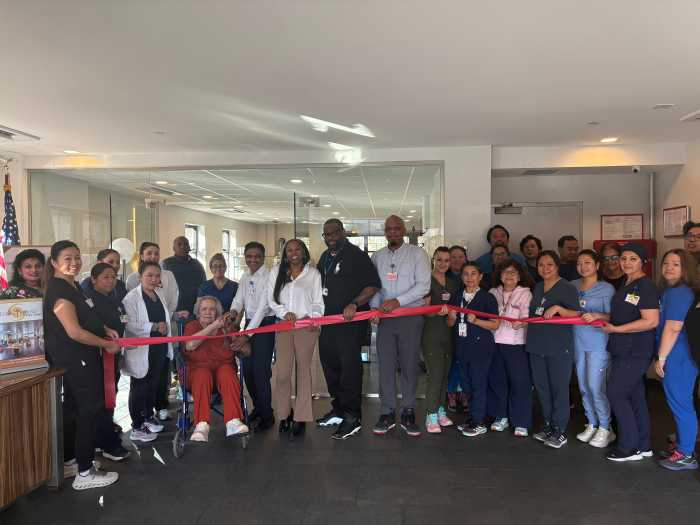Jackson Heights has been known as one of the most diverse and dynamic communities in the city with one of the highest concentrations of immigrants, many running their own businesses and making major contributions to the booming local economy.
On Oct. 24, state Comptroller Tom DiNapoli came to the Lexington School for the Deaf to release a report entitled “An Economic Snapshot of the Greater Jackson Heights Area” that backs that premise.
“Jackson Heights’ diverse and dynamic immigrant community is the driving force behind the local economy that has seen growth in the number of businesses, jobs and household income,” DiNapoli said. “Despite the neighborhood’s economic success, some challenges remain. The Jackson Heights area is living proof of the positive economic and cultural benefits immigration brings to our communities.”
Immigrants represented 60 percent of the area’s population in 2017, much higher than the citywide (37 percent) and the national (14 percent) shares. Immigrants also made up more than three-quarters of employed residents, the second highest share among New York City’s 55 Census-defined neighborhoods.
“Jackson Heights is thriving because of its diversity,” City Councilman Daniel Dromm said. “As Comptroller DiNapoli’s report illustrates, immigrants have made our local economy strong. Jackson Heights surpasses the citywide and borough wide business sales growth averages thanks to our newest New Yorkers.”
In 2018, there were 3,300 businesses — 660 more than in 2009. Many are small retail shops and restaurants that reflect the neighborhood’s diversity and early and nearly three-quarters had fewer than five employees, and 88 percent had fewer than 10 employees.
“Jackson Heights is showing the nation how a vibrant immigrant community strengthens our society, both culturally and economically,” Congresswoman Alexandria Ocasio-Cortez said. “We must continue to invest in ourselves — our housing, our education, our health care, and our small businesses — to further uplift working-class and immigrant communities.”
Private sector employment reached 20,900 in 2018, 23 percent higher than in 2009. This represents an increase of 4,000 private sector jobs, creating job opportunities for residents. Two-thirds of the jobs added were in retail, construction, and leisure and hospitality.
“Immigrant small business owners and their entrepreneurial spirit is the lifeblood of our local economy,” City Councilman Francisco Moys said. “When you walk down Roosevelt Avenue, you can smell Mexican food cooking in taquerias, hear Dominican music playing in the mom and pop shops, and see people shopping in Colombian markets or sporting Ecuadorian soccer jerseys. Our diversity is a point of pride and a testament that the American Dream is an immigrant’s story.”
Of the 102,300 immigrants in the Jackson Heights area in 2017, Ecuadorians were the largest group representing one-fifth (20,8000) of the immigrant population. Dominicans were the second-largest group (14,400), followed by Mexicans (11,800), Bangladeshis, Colombians, Peruvians, Chinese and Indians also made up significant shares.
“My constituents have a rich cultural history both within their own ethnicities, and those that they have created through their dedication to their neighborhoods,” Assemblywoman Catalina Cruz said. Cruz was born in Colombia and came to Queens at the age of 9. She grew up as a DREAMer and lived in the United States for more than 10 years as an undocumented American.
“The release of this report on Jackson Heights reaffirms all the good news that we already knew: that Queens is a great place to live, work and play,” Queens Chamber of Commerce President and CEO Thomas J. Grech said. “As a proud third generation American of Maltese, Spanish and Austrian descent, I know well the benefits of diversity as well evidenced in the Jackson Heights report.”
The U.S. Census Bureau estimates that the unemployment rate in the greater Jackson Heights area, which includes North Corona and East Elmhurst, fell from the recessionary peak of 10.3 percent in 2010 to 4.2 percent in 2017, lower than the rate in Queens (5.2 percent) and the city (6.4 percent).
“The hard work and entrepreneurial spirit of our immigrant population helps make Jackson Heights and all of ‘The World’s Borough’ a powerful economic force,” Queens Borough President Melinda Katz said. “Comptroller DiNapoli and his team deserve to be commended for producing this compelling report.”
You can read An Economic Snapshot of the Greater Jackson Heights Area here.



































